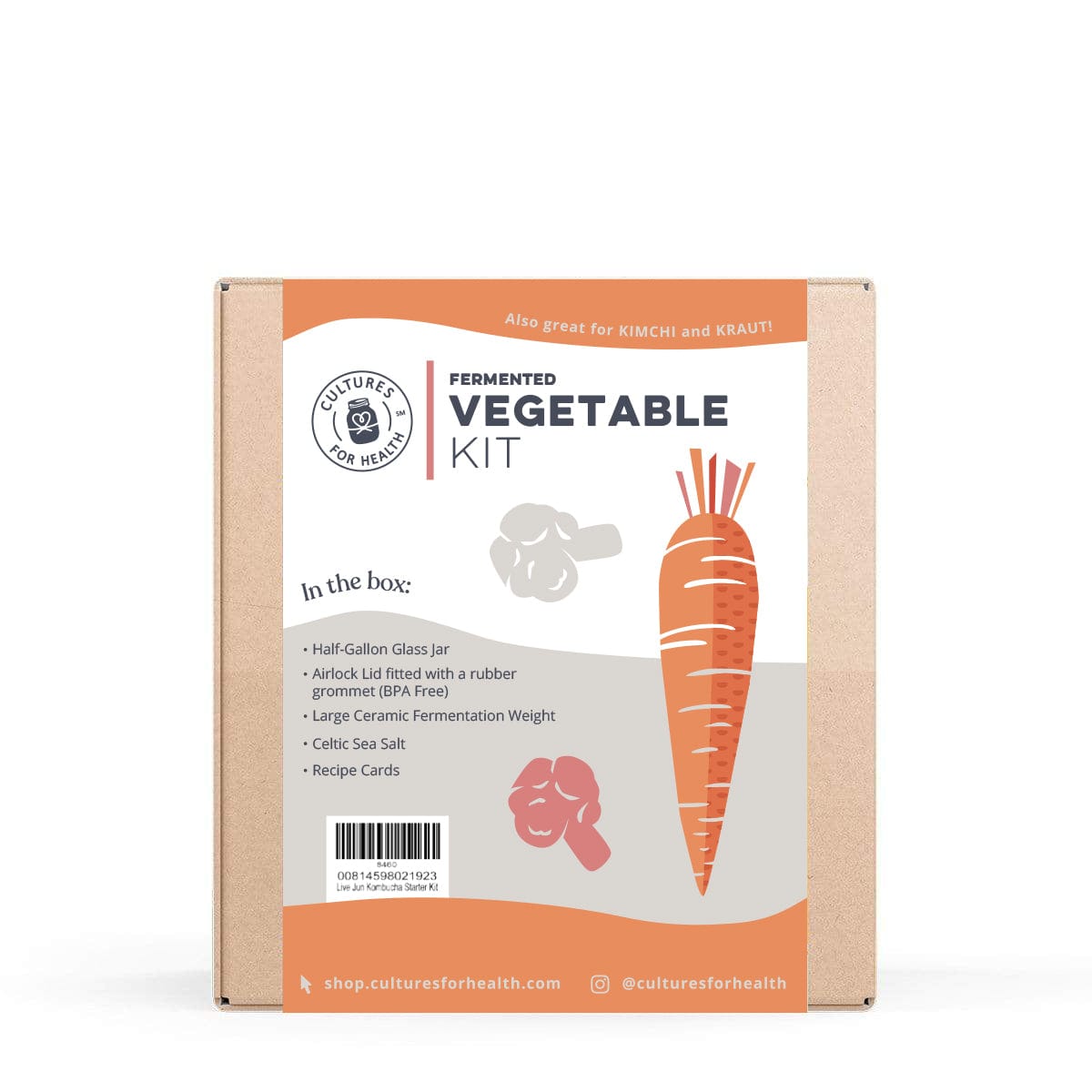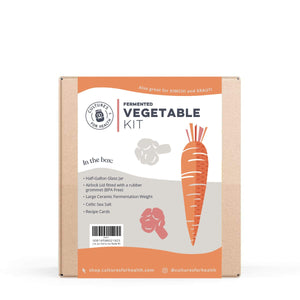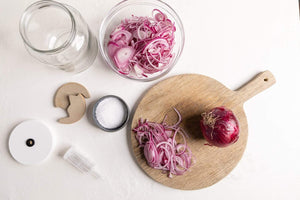
Ever wondered how all those lip-smacking pickles, spicy and tangy kimchi, rich yogurts, and refreshing beers that you consume on a regular basis are prepared? Ever since the Neolithic age, our ancestors have been using the help of a process known as “fermentation” to prepare some of the most delicious, healthy, and easy-to-digest delicacies that otherwise would have never existed.
Now that we have your attention, we’re sure the first few questions that pop up in your head are “What causes fermentation?” and “How does fermentation even work?” but above all, “What is fermentation?” You’ll find all of your queries answered in this article, along with some excellent health benefits offered by this process and a step-by-step guide to start fermenting your own food!
On an elementary level, fermentation is a metabolic process that occurs in the absence of oxygen, during which microorganisms such as yeast, bacteria, or fungi convert carbohydrates (such as sugars or starches) into other compounds, such as alcohol, organic acids, or gasses. With this brief insight into fermentation, let’s dig a little deeper.
The Science Behind Fermentation

Now that you know that it is the presence of the countless microbes that causes fermentation, let's unfold another layer and discover how fermentation works. Just like any other living being, all microbes require food to fuel themselves on an everyday basis. However, unlike human beings that undergo the respiration process in the presence of oxygen, some of these microbes use another process called anaerobic respiration, which works in the absence of oxygen. Through this process of anaerobic respiration, these microbes convert the food items into a more savory or boozy substance, thus “fermenting” it.
How Does Fermentation Work?
With a better idea of the science behind fermentation and the processes that are carried out on a microscopic level, we have a clearer vision in terms of how fermentation works and why fermentation occurs. However, the process of fermentation is quite broad. It can be ideally categorized into three main types based on the factors that cause fermentation as well as the initial ingredients and final products involved. Those three variations are:
-
Acetic Acid Fermentation: This process of fermentation is used to produce several kinds of vinegar, or “cider vinegar” that we use on an everyday basis. This is made possible because of a simple chemical reaction known as oxidation.
-
Lactic Acid Fermentation: This is the type of fermentation process that you are probably more familiar with, because of its frequent use in our day-to-day lives. Microbes like yeast and some probiotic bacteria convert the sugars present naturally in everyday foods, such as vegetables, fruits, and even milk, to provide us with delightfully tangy meals like kimchi, pickles, and sauerkraut. This process is also the backbone of the baking industry, since many baked treats like breads, sourdoughs, pizzas, and rolls get that characteristic fluffiness and lift because of the action of yeast.
-
Ethyl Alcohol Fermentation: This type of fermentation is usually witnessed in the booze industry. Just like the name suggests, this process involves breaking down sugars by specific types of yeast to convert the carbs to ethyl alcohol, the key ingredient of consumable alcohol.
While the underlying principle of fermentation remains the same (converting sugars into several other types of molecules via anaerobic respiration to generate energy), each process requires unique environmental conditions, sugars, and even unique types of bacteria that cause fermentation.
What Causes Fermentation?
When these microbes are subjected to an environment where they either have very restricted access to oxygen or no oxygen at all, they incline toward the process of anaerobic respiration. This, in essence, is the process of decomposing their food (or “digesting” it, so to speak) into an energy molecule named adenosine triphosphate (named simply for the compound formed by one adenosine molecule and three phosphate groups).
These molecules are the chemical compounds that are required by all living beings to carry energy and complete their life processes.
This same anaerobic respiration process also produces several chemical compounds as by-products that give a characteristic smell or taste to the items being fermented. It is the presence of these by-products that give that signature tart, zesty flavor to our favorite pickles, kimchis, wines, and beers. Therefore, every time you ask yourself “How does fermentation work?” all you have to keep in mind is the work of our tiny microscopic friends, turning sugars into energy and leaving us their tasty extras.
Getting Started With Fermentation: Some Popular Fermented Foods And Drinks

Although the underlying science behind fermentation is a comparatively recent discovery, the concept of fermentation dates all the way back to 6000 B.C.E. Cultures from all over the world have adopted some sort of fermented food or beverage in their regular meals, because they understood the preservative qualities, immense health benefits, and the distinctive zing it brought to the flavor profile of an otherwise ordinary dish.
Here are some of the popular fermented foods and beverages that you may or may not be familiar with—but that you can make at home with just a few fermentation supplies:
-
Kimchi: A staple in Korean cuisine, kimchi is rapidly spreading its popularity in other cultures and countries as well. Known for its hot, full flavor, there's little doubt about this food item being one of the most popular options when it comes to fermented food. Made from fermented veggies, usually cabbage, authentic kimchi has a very distinctive spicy flavor with a unique umami twist, made possible by the fermentation process.
-
Kombucha: A highly popular fermented beverage, kombucha is a mildly effervescent black tea that is well-known for the plethora of benefits it offers for your gut health, all from a simple SCOBY. Popularized not until recently to the outer world, the Chinese have known the kombucha benefits as early as 220 B.C.E.
-
Pickles: Did you know that veggies pickled in a slightly acidic and savory brine also undergo the process of fermentation? While many modern pickles are actually “quick pickled” in vinegar, some of the highest quality pickles at your local grocery store still use this same process.
-
Sauerkraut: This tangy cabbage dish started out as a way to preserve fresh cabbage to eat all winter, but it’s so tasty that it’s become a staple all over the world and a New Year’s good luck charm!
-
Beer & Wine: No party is officially complete without raising a toast for the host of the party. However, did you know that all of your favorite brands of beer and wines ferment their beverages to develop that characteristic flavor and make those drinks ‘boozy’? Beers and Wines have been consumed for ages and the basic process of preparing alcohol out of organic matter remains the same no matter how much technology advances.
-
Gochujang: Another popular fermented cuisine originating from Korea. Gochujang is a spicy paste known for its distinct spicy kick accompanied by a mild sweetness and intense umami flavor. Although more and more people from around the world are starting to come up with their own versions of homemade Gochujang, the authentic recipe remains unrivaled.
-
Miso: If you are a fan of ramen and Japanese cuisine in general, you’re probably aware of what miso is: an intensely flavorful paste made from fermented and mashed soybeans that is widely used in many Japanese dishes, most notably in Japanese Miso Ramen. This unique food is probably one of the best examples of the rich umami that the process of fermentation brings to food items.
Fermented Vegetable Kit
$35.99$40.99Make tasty fermented veggies at home with our DIY Fermented Vegetable Kit! This kit is also great for making kimchi, sauerkraut, and more! Equipment in the kit may appear different than pictured. INCLUDED IN THE KIT Half-Gallon Fermentation Jar Airlock Lid fitted with rubber grommets Ceramic Fermentation Weights Celtic Sea Salt Recipe cards USING THE...
Health Benefits Of Consuming Fermented Food

All this talk about fermented food, how does fermentation work, what causes fermentation, and why does fermentation occur leads us to some valid reasons to include fermented food in our everyday life—and not just for just taste! Here are some well-researched and scientifically backed health benefits that you can enjoy by making fermented foods a part of your regular diet:
-
Increased Probiotic Density: Also known as the “healthy bacteria,” probiotics are said to aid in our gut health and gastrointestinal functions. More probiotics means enhanced digestion and better overall gut health.
-
Antioxidants: Fermented foods are generally rich in antioxidants, which significantly reduces the risk of a lot of cardiovascular diseases.
-
Enhanced Immunity: Since fermented foods are a rich source of probiotics (aka, the good bacteria), they are a well-known source to boost your immunity and thus make your body less prone to diseases and other ailments.
-
Weight Management: If you are looking to lose some extra pounds, fermented foods can be one of your best allies to not only meet your nutritional requirements, but even to lose weight faster. Fermented foods, especially all kinds of fermented vegetables, are usually low in calories, high in fiber—and high in flavor! And that’s even before you look at the probiotic weight loss benefits.
Easily Ferment Foods At Home

Familiarizing yourself with the entire process of fermentation and the science behind how fermentation works might seem overwhelming to you at first glance. “Fermenting food must be so tough”—that's probably what you’re thinking right now. Well, you know what? The process of fermenting everyday food items is really a very simple one, and believe it or not, you have probably already fermented a couple of food items already, either intentionally or unintentionally!
Remember the yogurt that you bought the other day? Or that loaf of sourdough bread that you baked at home from scratch? Or the kefir starter you have going at home? All of those recipes had fermentation working itself out behind the scenes.
Starting the process of fermentation in almost any food item requires just three things: the bacteria, the source of sugar/carbohydrates, and a hygienic, uncontaminated environment with ideally as little oxygen as possible. Combine all these together and let time do its magic to change your everyday food into something special, and full of that distinctive zing.
Tips For Successful Fermentation
-
Do your research and use tested, proven fermentation recipes. This isn’t the area to start out by winging it!
-
Limit the exposure to oxygen as much as possible.
-
Use a clean, sanitized container to carry out your fermentation; additionally, ensure that the environment is as hygienic as it can possibly get.
-
Fill the brine (if any) to the top and leave no air bubbles.
-
Maintain an ideal temperature.
-
Be patient! Don't disturb the process by constantly checking to see if it’s done.
Summing Up How Fermentation Works
The rich history of fermentation and fermented food has certainly been backed by a time-tested history of gut health and delightful flavors. When carried out in a clean environment with well-researched recipes, you too will be able to achieve the perfect umami-ness, savoriness, or booziness that you set out to produce.
Only buying your fermented foods doesn’t always scratch that itch. The satisfaction and quality that you experience by fermenting your own food remains unrivaled. Now that you have all the pieces of the puzzle—the science behind the process of fermentation, the explanation of how fermentation works, what causes fermentation or why fermentation occurs—all you need is the hands-on experience of preparing your own fermented foods to actually appreciate the taste and countless health benefits it brings.































